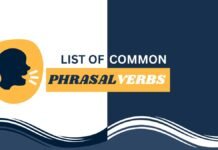Verbs play a crucial role in the English language, allowing us to express actions, states, and conditions. However, not all verbs can be used in the continuous form. In this blog post, we will explore a list of verbs not used in the continuous form and understand the reasons behind this grammatical rule.
TABLE OF CONTENT
What is the Continuous Form?
The continuous form, also known as the progressive form, is used to indicate actions that are happening at the moment of speaking or around a specific time. We form it by using the auxiliary verb “be” in the appropriate tense and adding the present participle of the main verb (verb+ing).
For example:
- I am studying for my exam.
- She was cooking dinner when the phone rang.
- They will be waiting for you at the airport.
In English, some verbs are not used in the continuous, be it present continuous, past continuous, or future continuous. That is to say, these verbs rarely take the ING form. These verbs are not used in the continuous form because they are considered stative verbs, expressing a state or condition rather than an ongoing action.They are often verbs that describe states of being, thinking, possessing, or feeling.
✘ I am liking sports
✔ I like sports
Verbs Not Used in the Continuous Form
Here is a list of the most frequent verbs not used in the continuous:
1. Verbs of being: be, consist of, contain, exist
2. Verbs of possession: belong to, have (= own), include, lack, own, possess
3. Verbs of feeling: adore, desire, despise, detest, dislike, envy, hate, like, love, need, pity, prefer, trust, want, wish
4. Verbs of thinking: believe, doubt, expect, feel (= think), forget, imagine, intend, know, realise, recognise, remember, see (= understand), suppose, think, understand
5. Verbs of appearance: appear, resemble, seem
6. Other verbs: concern, depend, deserve, fit, matter, measure, mean, mind, weigh.
Exceptions to the Rule
Yet, many verbs mentioned before may be used in the continuous, but the verb either has a different meaning or expresses a temporary action.
I am thinking of buying a new car (thinking = considering)
Check out this list to see the differences:
- Verb: Be
Use in the present simple: He is a careful person
Use in the present continuous: He is being careful (is behaving carefully).
- Verb: Have
Use in the present simple: I have a car (I own it)
Use in the present continuous: The kids are having fun at the park (are experiencing)
- Verb: Think
Use in the present simple: I think the patient is getting better
Use in the present continuous: I am thinking of buying a new car (thinking = considering)
- Verb: Mean
Use in the present simple: The sign means ‘pay attention’
Use in the present continuous: Tom is always meaning to help us (intending or willing).
- Verb: Appear
Use in the present simple: Quinn appears to be a kind person (=seems to be)
Use in the present continuous: The actor is appearing on the stage (is performing)
- Verb: Weigh
Use in the present simple: She weighs 70 kilos
Use in the present continuous: I am weighing the flour (the action of weighing)
Conclusion
Understanding which verbs are not used in the continuous form is crucial for accurate and effective communication in English. By recognizing the verbs mentioned above as stative or expressing a state, we can use them appropriately in different contexts. Remember, context plays a vital role in determining whether to use the continuous form or the simple form of a verb.
So, the next time you come across one of these verbs, you’ll know why it doesn’t fit in the continuous form!



